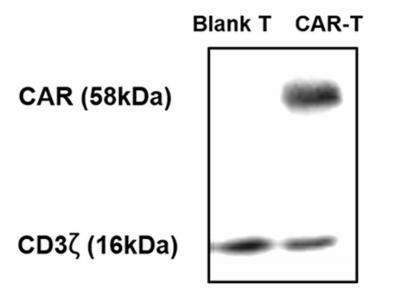CD3 zeta Antibody - #AF5405
| 製品: | CD3 zeta Antibody |
| カタログ: | AF5405 |
| タンパク質の説明: | Rabbit polyclonal antibody to CD3 zeta |
| アプリケーション: | WB IF/ICC |
| Cited expt.: | WB, IF/ICC |
| 反応性: | Human, Mouse |
| 予測: | Pig, Bovine, Horse, Sheep, Rabbit |
| 分子量: | 19 kDa; 19kD(Calculated). |
| ユニプロット: | P20963 |
| RRID: | AB_2837889 |
製品説明
*The optimal dilutions should be determined by the end user.
*Tips:
WB: For western blot detection of denatured protein samples. IHC: For immunohistochemical detection of paraffin sections (IHC-p) or frozen sections (IHC-f) of tissue samples. IF/ICC: For immunofluorescence detection of cell samples. ELISA(peptide): For ELISA detection of antigenic peptide.
引用形式: Affinity Biosciences Cat# AF5405, RRID:AB_2837889.
折りたたみ/展開
4930549J05Rik; A430104F18Rik; AW552088; CD247; CD247 antigen; Cd247 molecule; Cd3; CD3 antigen, zeta polypeptide, isoform CRA_b; CD3 antigen, zeta subunit; CD3-eta; CD3H; CD3Q; Cd3z; CD3Z antigen zeta polypeptide (TiT3 complex); CD3Z_HUMAN; CD3zeta; CD3zeta chain; MGC140430; T cell receptor T3 zeta chain; T cell surface glycoprotein CD3 zeta chain; T-cell antigen receptor complex, zeta subunit of CD3; T-cell receptor T3 zeta chain; T-cell surface glycoprotein CD3 zeta chain; T3z; TCR zeta chain; TCRk; TCRZ; TCRzeta;
免疫原
A synthesized peptide derived from human CD3 zeta, corresponding to a region within C-terminal amino acids.
CD3Z is expressed in normal lymphoid tissue and in peripheral blood mononuclear cells (PBMCs) (PubMed:11722641).
- P20963 CD3Z_HUMAN:
- Protein BLAST With
- NCBI/
- ExPASy/
- Uniprot
MKWKALFTAAILQAQLPITEAQSFGLLDPKLCYLLDGILFIYGVILTALFLRVKFSRSADAPAYQQGQNQLYNELNLGRREEYDVLDKRRGRDPEMGGKPQRRKNPQEGLYNELQKDKMAEAYSEIGMKGERRRGKGHDGLYQGLSTATKDTYDALHMQALPPR
種類予測
Score>80(red) has high confidence and is suggested to be used for WB detection. *The prediction model is mainly based on the alignment of immunogen sequences, the results are for reference only, not as the basis of quality assurance.
High(score>80) Medium(80>score>50) Low(score<50) No confidence
研究背景
Part of the TCR-CD3 complex present on T-lymphocyte cell surface that plays an essential role in adaptive immune response. When antigen presenting cells (APCs) activate T-cell receptor (TCR), TCR-mediated signals are transmitted across the cell membrane by the CD3 chains CD3D, CD3E, CD3G and CD3Z. All CD3 chains contain immunoreceptor tyrosine-based activation motifs (ITAMs) in their cytoplasmic domain. Upon TCR engagement, these motifs become phosphorylated by Src family protein tyrosine kinases LCK and FYN, resulting in the activation of downstream signaling pathways. CD3Z ITAMs phosphorylation creates multiple docking sites for the protein kinase ZAP70 leading to ZAP70 phosphorylation and its conversion into a catalytically active enzyme. Plays an important role in intrathymic T-cell differentiation. Additionally, participates in the activity-dependent synapse formation of retinal ganglion cells (RGCs) in both the retina and dorsal lateral geniculate nucleus (dLGN) (By similarity).
Phosphorylated on Tyr residues after T-cell receptor triggering by LCK in association with CD4/CD8.
Membrane>Single-pass type I membrane protein.
CD3Z is expressed in normal lymphoid tissue and in peripheral blood mononuclear cells (PBMCs).
The ITAM domains mediate interaction with SHB.
Belongs to the CD3Z/FCER1G family.
研究領域
· Human Diseases > Infectious diseases: Parasitic > Chagas disease (American trypanosomiasis).
· Organismal Systems > Immune system > Natural killer cell mediated cytotoxicity. (View pathway)
· Organismal Systems > Immune system > Th1 and Th2 cell differentiation. (View pathway)
· Organismal Systems > Immune system > Th17 cell differentiation. (View pathway)
· Organismal Systems > Immune system > T cell receptor signaling pathway. (View pathway)
参考文献
Application: IF/ICC Species: Mice Sample: liver tissue
Application: WB Species: mouse Sample: CAR-T cells
Restrictive clause
Affinity Biosciences tests all products strictly. Citations are provided as a resource for additional applications that have not been validated by Affinity Biosciences. Please choose the appropriate format for each application and consult Materials and Methods sections for additional details about the use of any product in these publications.
For Research Use Only.
Not for use in diagnostic or therapeutic procedures. Not for resale. Not for distribution without written consent. Affinity Biosciences will not be held responsible for patent infringement or other violations that may occur with the use of our products. Affinity Biosciences, Affinity Biosciences Logo and all other trademarks are the property of Affinity Biosciences LTD.

